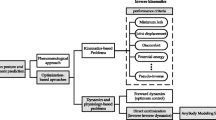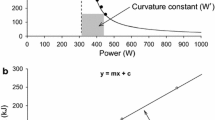Abstract
A simple mathematical model is used to find the optimal distribution of a cyclist’s effort during a time trial. It is shown that maintaining a constant velocity is optimal if the goal is to minimise the time taken to complete the course while fixing amount of work done. However, this is usually impractical on a non-flat course because the cyclist would be unable to maintain the power output required on the climbs. A model for exertion is introduced and used to identify the distribution of power that minimises time while restricting the cyclist’s exertion. It is shown that, for a course with a climb followed by a descent, limits on exertion prevent the cyclist from improving performance by shifting effort towards the climb and away from the descent. It is also shown, however, that significant improvement is possible on a course with several climbs and descents. An analogous problem with climbs and descents replaced by headwinds and tailwinds is considered and it is shown that there is no significant advantage to be gained by varying power output. Lagrange multipliers are used solve the minimisation problems.
Similar content being viewed by others
Abbreviations
- P:
-
power output (W)
- Pc :
-
climbing power (W)
- Pd :
-
descending power (W)
- Pm :
-
maximum power (W)
- P0 :
-
critical power (W)
- W:
-
total work (J)
- v:
-
velocity (m s−1)
- vc :
-
climbing velocity (m s−1)
- vd :
-
descending velocity (m s−1)
- w:
-
headwind velocity (m s−1)
- t:
-
time (s)
- T:
-
time to complete course (s)
- D:
-
duration of effort at a fixed power output (s)
- x:
-
distance travelled (m)
- xc :
-
climb length (m)
- xd :
-
descent length (m)
- L:
-
course length (m)
- R:
-
rate of exertion
- E:
-
exertion
- m:
-
mass of cyclist with bicycle (kg)
- g:
-
9.8 m s−2
- c:
-
drag coefficient (kg m−1)
- μ:
-
friction coefficient
- s:
-
road grade
- sc :
-
climbing grade
- sd :
-
descending grade
References
Atkinson, G., Davison, R., Jeukendrup, A. & Passfield, L. (2003) Science and cycling: Current knowledge and future directions for research.Journal of Sports Sciences,21, 767–787.
Broker, J.P. (2003) Cycling power: road and mountain. In:High-Tech Cycling (ed. Burke, E. R.), pp. 147–174. Human Kinetics, Champaign, IL.
Broker, J.P., Kyle, C. R. & Burke, E.R. (1999) Racing cyclist power requirements in the 4000-m individual and team pursuits.Medicine & Science in Sports & Exercise,31(11), 1677.
Coats, E.M., Rossiter, H.B., Day, J.R., Miura, A., Fukuba, Y. & Whipp, B.J (2003) Intensity-dependant tolerance to exercise after attainingVO 2max in humans.Journal of Applied Physiology,95(2), 483–490.
Gaesser, G.A. & Brooks, G.A. (1975) Muscular efficiency during steady-rate exercise: Effects of speed and work rate.Journal of Applied Physiology,38(6), 1132–1139.
Keen, P. (1994) The truth behind the race of truth.Cycle Sport, July, 46–50.
Kyle, C.R. (2003) Selecting cycling equipment. In:High-Tech Cycling (ed. Burke, E. R.), pp. 1–48, Human Kinetics, Champaign, IL.
Liedl, M.A., Swain, D.P. & Branch, J.D. (1999) Physiological effects of constant versus variable power during endurance cycling.Medicine & Science in Sports & Exercise,31(10), 1472–1477.
Lucía, A., Hoyos, J. & Chicharro, J. (2003) Physiology of professional road cycling. In:High-Tech Cycling (ed. Burke, E. R.), pp. 265–288. Human Kinetics, Champaign, IL.
Margaria, R. (1976)Biomechanics and Energetics of Muscular Exercise. Oxford University Press, Oxford.
Moritani, T., Nagata, A. & DeVries, H.A. (1981) Critical Power as a measure of physical work capacity and anaerobic threshold.Ergonomics,24, 339–350.
Morton, R.H. (1985) On a model of human bioenergetics.European Journal of Applied Physiology,54, 285–290.
Morton, R.H. (1996) A 3-parameters critical power model.Ergonomics,39, 611–619.
Skinner, J.S. & McLellan, T.H. (1980) The transition from aerobic and anaerobic metabolism.Res. Q. Exerc. Sport,51, 234–248.
Swain, David P. (1997) A model for optimising cycling performance by varying power on hills and in wind.Medicine & Science in Sports & Exercise,29(8), 1104–1108.
Whitt, F.R. & Wilson, D.G. (1983)Bicycling Science. MIT Press, Cambridge, Mass., p. 51.
Author information
Authors and Affiliations
Corresponding author
Rights and permissions
About this article
Cite this article
Gordon, S. Optimising distribution of power during a cycling time trial. Sports Eng 8, 81–90 (2005). https://doi.org/10.1007/BF02844006
Issue Date:
DOI: https://doi.org/10.1007/BF02844006




